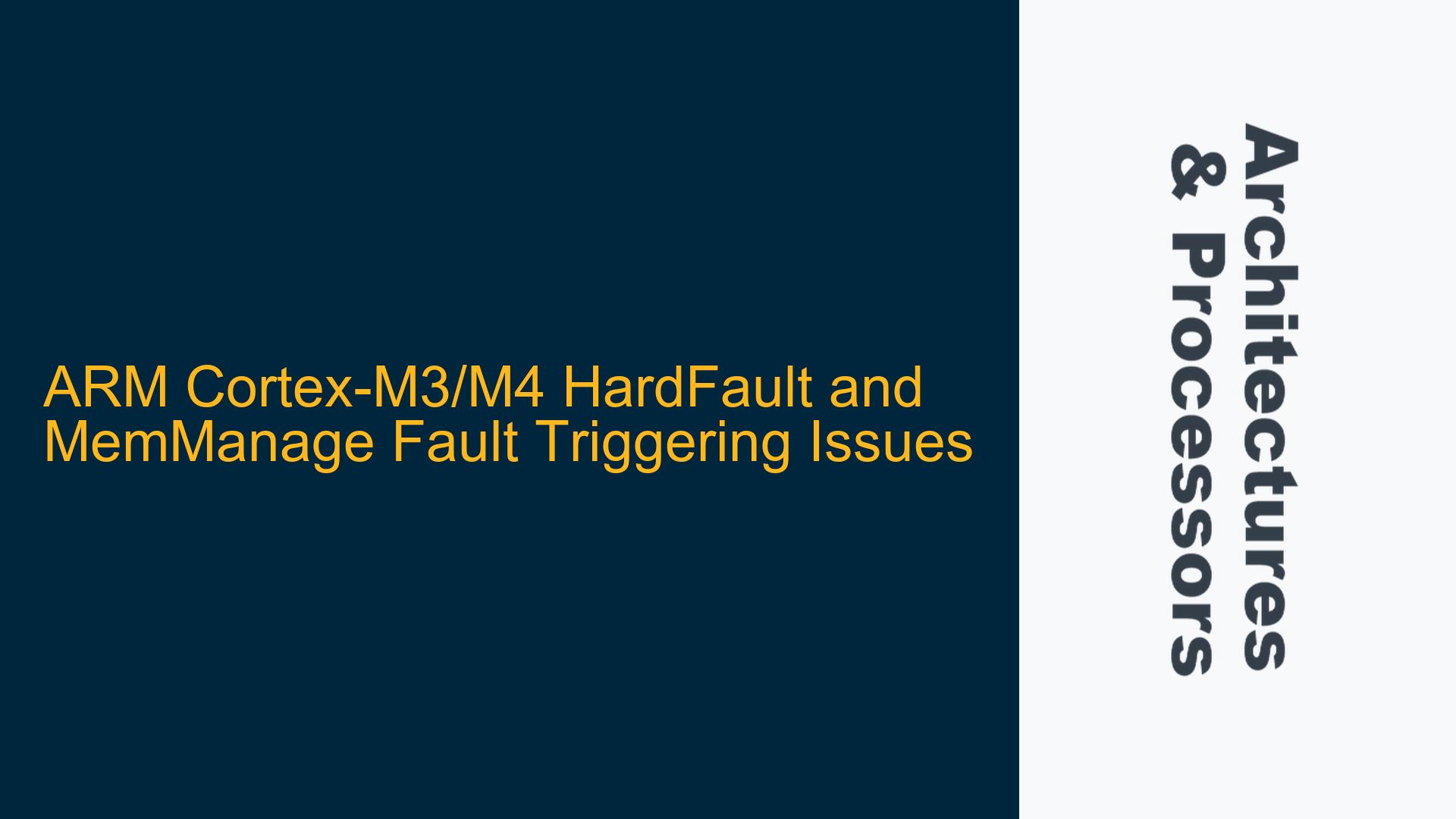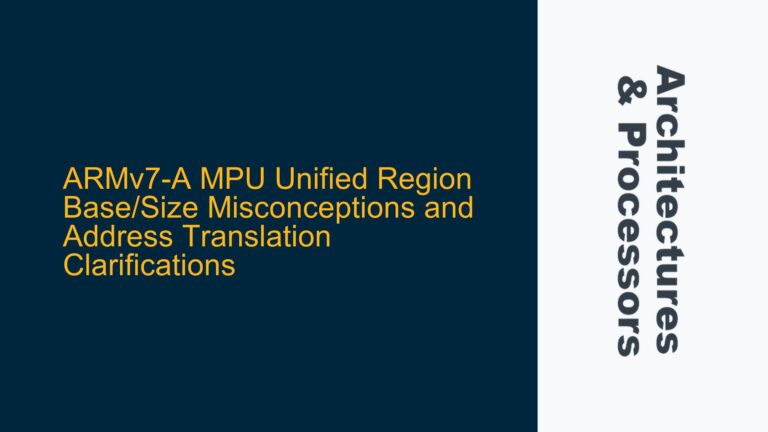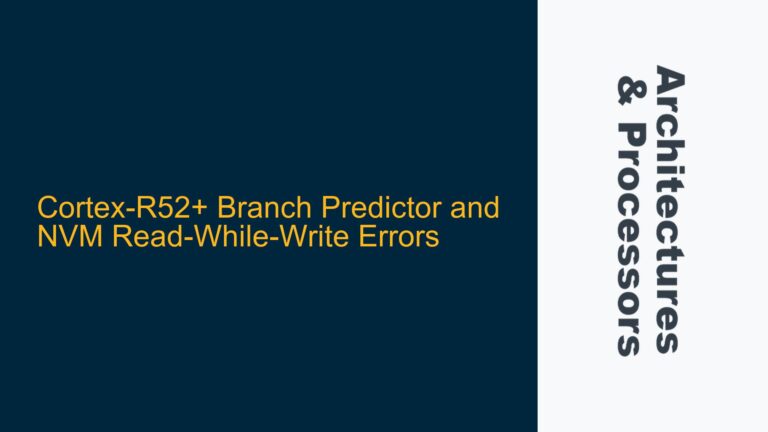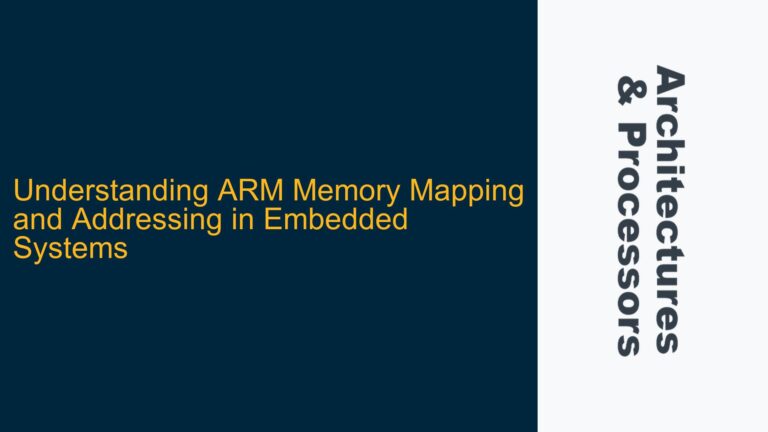Illegal Memory Access and Fault Handling Mechanism in Cortex-M3/M4
The ARM Cortex-M3 and Cortex-M4 processors are designed with robust fault handling mechanisms to detect and manage illegal memory accesses, among other issues. When a program attempts to write to an illegal memory location, the processor is expected to trigger a MemManage fault. If the MemManage fault handler is not enabled, the fault should escalate to a HardFault. However, in some cases, neither fault is triggered, leading to unexpected behavior and potential system instability.
The core issue revolves around the processor’s response to illegal memory accesses. Specifically, when a program writes to an illegal memory location, such as 0xE0100000, the expected fault sequence (MemManage fault escalating to HardFault) does not occur. Instead, the system may only print an error message without triggering the appropriate fault handlers. This behavior can be attributed to several factors, including system-level integration, memory protection unit (MPU) configuration, and fault handling settings.
Understanding the fault handling mechanism in Cortex-M3/M4 processors is crucial for diagnosing and resolving this issue. The MemManage fault is designed to catch memory access violations, such as writing to reserved or unallocated memory regions. If the MemManage fault handler is not enabled, the fault should escalate to a HardFault, which is a catch-all fault handler for severe system errors. However, the absence of fault triggering indicates a potential misconfiguration or system-level issue that prevents the processor from recognizing the illegal access as a fault condition.
System-Level Integration and Memory Protection Unit (MPU) Configuration
The behavior of the Cortex-M3/M4 processor when accessing illegal memory locations is heavily influenced by system-level integration and the configuration of the Memory Protection Unit (MPU). The MPU is a critical component that defines memory regions and their access permissions. If the MPU is not properly configured, the processor may not recognize certain memory accesses as illegal, leading to the absence of fault triggering.
In the case of writing to an illegal memory location, such as 0xE0100000, the MPU should be configured to mark this region as inaccessible. If the MPU is not enabled or is misconfigured, the processor may not detect the illegal access, resulting in the absence of a MemManage fault. Additionally, the system-level integration of the Cortex-M3/M4 processor plays a significant role in fault handling. Depending on how the processor is integrated into the system, certain illegal accesses may not generate a trap for the CPU, leading to the observed behavior.
The MPU configuration must be carefully reviewed to ensure that all memory regions are properly defined with the correct access permissions. The MPU typically supports multiple regions, each with configurable attributes such as size, base address, access permissions, and memory type. If the MPU is not configured to cover the entire memory map, certain regions may be left unprotected, allowing illegal accesses to go unnoticed.
Furthermore, the system-level integration must be considered, as the behavior of the processor can vary depending on the specific implementation. For example, some systems may include external memory controllers or bus fabric that handle memory accesses differently, potentially bypassing the MPU or fault handling mechanisms. In such cases, the illegal access may not be detected by the processor, leading to the absence of fault triggering.
Implementing Proper Fault Handling and Debugging Techniques
To address the issue of missing fault triggering in Cortex-M3/M4 processors, several steps can be taken to ensure proper fault handling and debugging. These steps include enabling and configuring the MPU, verifying fault handling settings, and using debugging tools to trace the execution flow and identify the root cause of the issue.
First, the MPU must be enabled and properly configured to cover all memory regions, including those that should be marked as inaccessible. The MPU configuration should be reviewed to ensure that the base address, size, and access permissions are correctly set for each region. Additionally, the MPU should be configured to generate a MemManage fault for any illegal access, ensuring that the fault handler is triggered when an illegal memory access occurs.
Next, the fault handling settings must be verified to ensure that the MemManage fault handler is enabled and that the fault escalation to HardFault is properly configured. The System Handler Control and State Register (SHCSR) should be checked to confirm that the MemManage fault handler is enabled. If the MemManage fault handler is not enabled, the fault should escalate to the HardFault handler, which should be implemented to handle severe system errors.
Debugging tools, such as a JTAG debugger or SWO trace, can be used to trace the execution flow and identify the point at which the illegal memory access occurs. By setting breakpoints and examining the processor’s registers and memory, the root cause of the issue can be identified. Additionally, the fault status registers, such as the MemManage Fault Status Register (MMFSR) and HardFault Status Register (HFSR), should be examined to determine the cause of the fault and whether it was triggered correctly.
In cases where the fault is not triggered, the system-level integration should be reviewed to ensure that the processor’s fault handling mechanisms are not being bypassed. This may involve examining the system’s memory map, bus fabric, and external memory controllers to identify any potential issues that could prevent the processor from detecting illegal memory accesses.
Finally, it is important to implement proper error handling and recovery mechanisms in the fault handlers to ensure that the system can recover from faults and continue operation. The MemManage fault handler should log the fault and take appropriate action, such as resetting the system or entering a safe state. The HardFault handler should handle severe system errors and ensure that the system can recover or shut down gracefully.
By following these steps, the issue of missing fault triggering in Cortex-M3/M4 processors can be resolved, ensuring that illegal memory accesses are properly detected and handled. Proper configuration of the MPU, verification of fault handling settings, and use of debugging tools are essential for diagnosing and resolving this issue, leading to a more robust and reliable system implementation.





